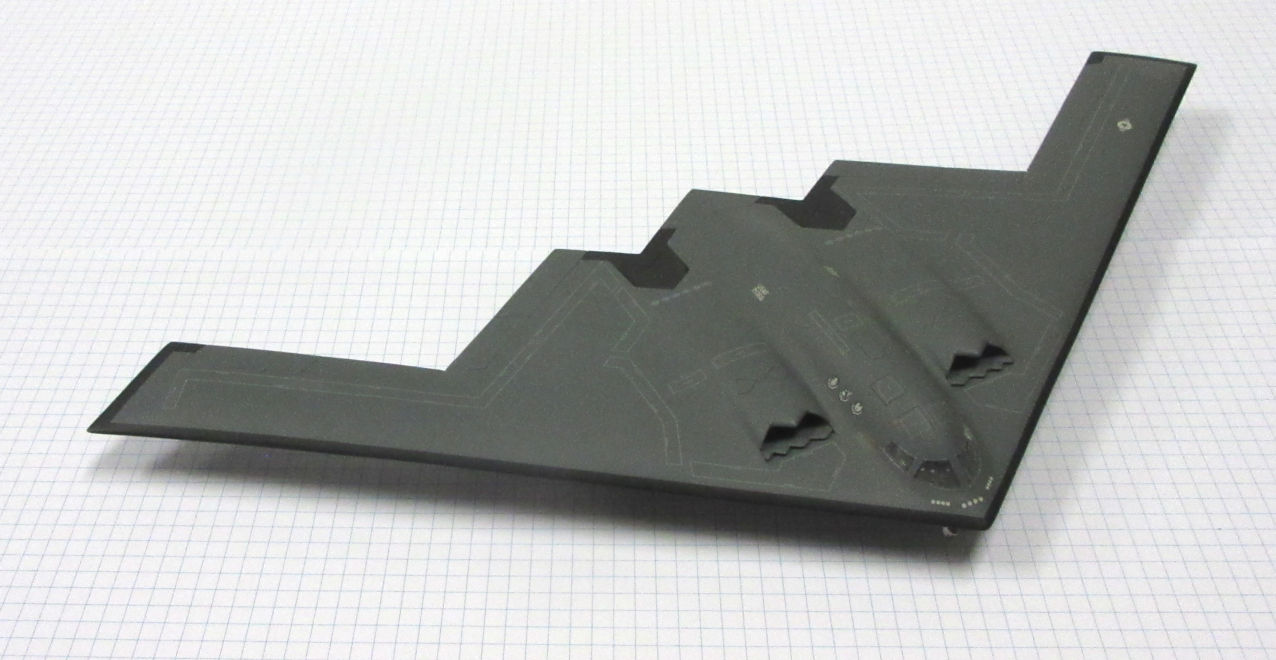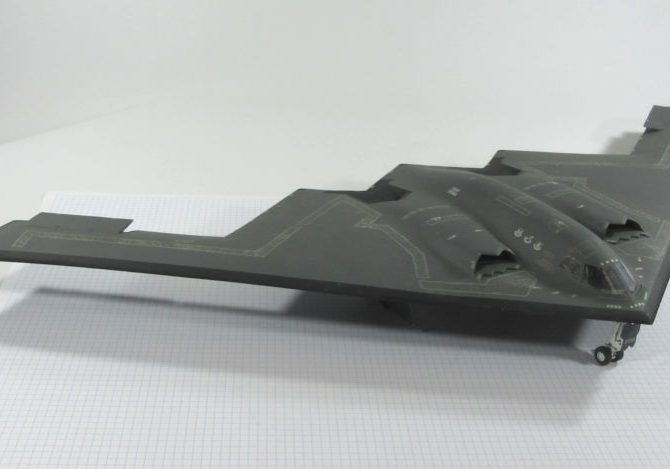By the beginning of the 1980s it was clear to United States defense planners that existing and envisaged air defense systems could detect and shoot down just about any aeroplane, making it impossible to effectively attack well defended targets. The solution to this problem appeared to be ‘stealth’ technology that made attacking aeroplanes invisible (or as good as) to enemy defenses. Consequently the United States Air Force began developing this new technology that led to the F-117 attack fighter and the B-2 strategic bomber. These two aeroplanes achieved their ‘stealth’ characteristics through different approaches but both have introduced new shapes and capability to the air. Both are expensive and complex to maintain but they also apparently work.
The B-2 began life as the ‘Advanced Technology Bomber’ developed by the Northrop Corporation that had been selected in 1981 as the prime contractor for this new project. Selection of Northrop for this project may have been the result of many decades of interest the company’s founder had shown in flying wings including the large B-35 and B-49 flying wing bombers and later experiments into flying wing technology.
The development of this new bomber involved more than 6000 companies developing not only the bomber itself but also the advanced technology needed to design it and give it many of its stealth characteristics. All the necessary developments came together in the first B-2 that was rolled out on 22 November 1988 and flew for the first time on 17 July 1989. The first operational B-2 was delivered to the USAF on 17 December 1993.
The complexity of the B-2 means that it is very costly with a unit price of around $1 billion and it is also costly and difficult to maintain in service. As a result, although the air force had originally planned that the B-2 would replace the ageing B-52s still in service, it could not afford to do so and planned to order only 132 of them. However, cost limited orders to only 21, all currently operated by the 509th Bomb Wing based at Whiteman Air force Base in Missouri. There have lately been attempts to revive production, partly so the United States would retain the capability to manufacture strategic bombers. The B-2 has been used operationally over Serbia, Afghanistan and Iraq and it is likely to remain in service for decades to come.
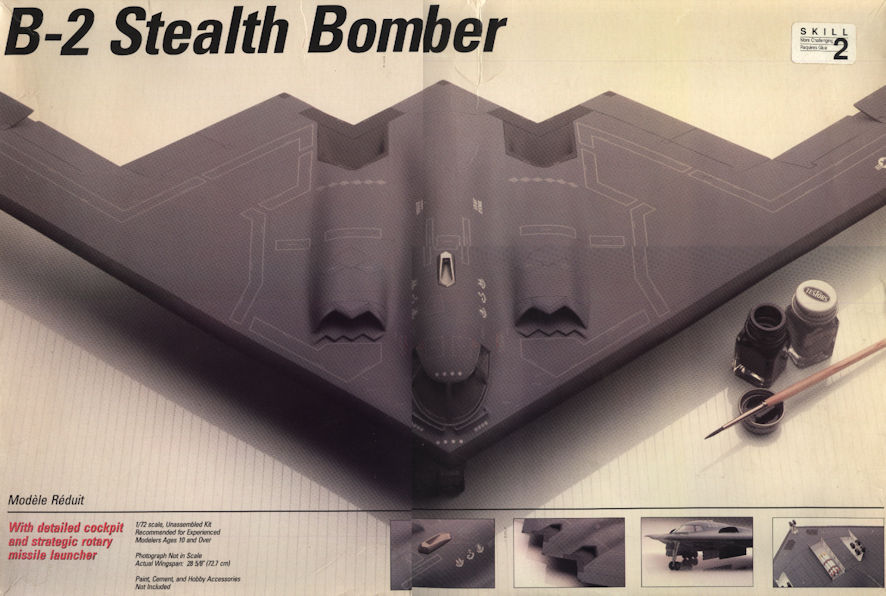
Talk about ugly. The B-2 looks as though somebody took a normal aeroplane, squashed it and threw away half the leftover bits. Still, it is an important aeroplane in the scheme of things and so it was probably inevitable that I would get around to making one sooner or later. The reason that I started making this kit sooner than later was because I felt the urge to build something that was big and simple, and this seemed to fit that description. As it turned out, it is big and it is relatively simple.
This kit came in a huge Testors box but I wouldn’t be surprised if the kit had originally come from AMT, the company that made a whole range of huge aircraft kits including the B-35 and B-49, a B-52, a KC-135 and the mighty XB-70. It has many things in common with those kits including a fairly detailed interior that is all but invisible when the model is completed, a certain ‘chunkiness’ in the kit parts and their layout on the sprues and a great generosity in the size of the gaps between major components.
In the XB-70 for example, the gaps between the major components needed very generous applications of filler, as did the wing halves in the YB-49. The same applies to this B-2. This was made worse by the way in which the inner and outer wing sections refused to line up to give a straight leading edge. The solution? Lots of filing gaps with strips of plasticard and more generous applications of filler. Getting all this to work out to a nice smooth finish took a couple of weeks, more or less. I was beginning to think that this was a kit that definitely didn’t want to be built.
Next came the painting. In theory very simple but there must be a lot of people around the place building aeroplanes that are Gunship Gray because I could only find two bottles of the Modelmasters stuff, and that was barely enough to cover this rather large aeroplane. Next was the leading edge of the wing that is black. Masking and painting it was no great trauma but when I pulled the masking tape off away came a fair amount of the gray on the underside where there was lots of filler. After a couple of weeks waiting I gave up and decided to use another paint brand of gunship gray. It looked okay before the gloss coat went on for the decals but then it turned out to be a shade or two lighter than the Modelmasters version. Thank god it’s not polite to pick up other people’s models and look at what’s underneath.
Then it came to the decals. The kit supplies a very nice sheet with all the walkway signs and stenciling you could want. I was really looking forward to bring this rather drab looking thing to life with them but… Arrgh! Even getting the walkway decals to line up well is a bit of a drama but it got worse when it appeared that the glue on the decals would not turn transparent again but remain a whitish gray, not at all how the B-2 should look. Urgent remedial action was needed so it was just as well that the decals were fairly robust. The less said about what followed, the better.
You wouldn’t think that such a relatively simple but large kit could cause such grief, at every turn it seemed to resist my attempts to build it. The end result is impressive but it could have been made a whole lot better had I known all these problems in advance.
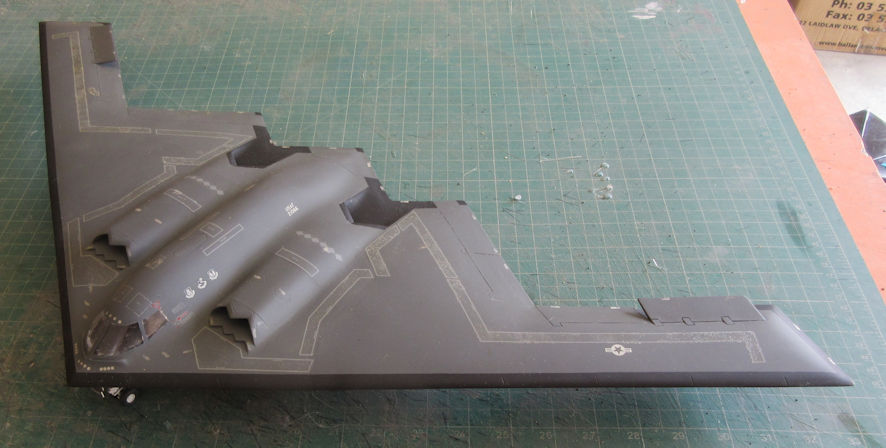
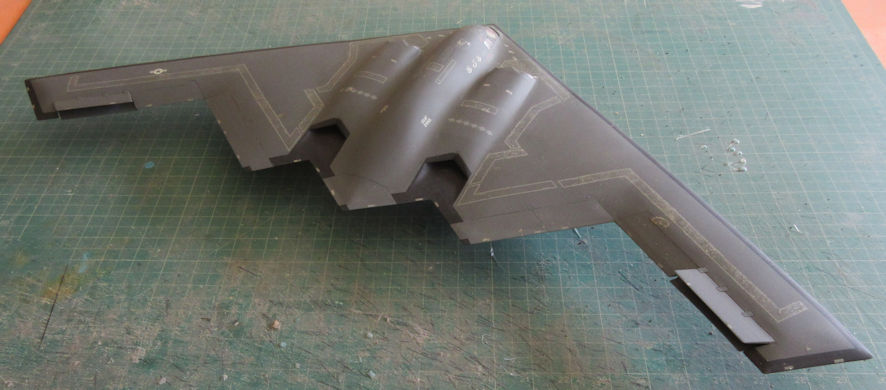
Leigh Edmonds
October 2004
